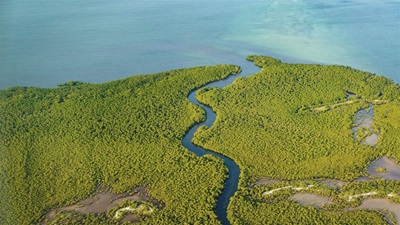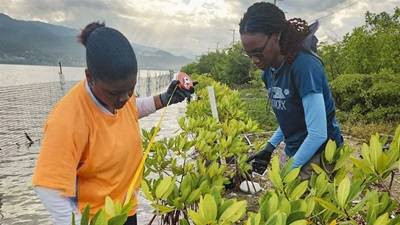Why Countries Should Invest in Coastal Wetlands Conservation Now
Sustainable financing is key for governments to meet Paris Agreement goals—and benefit people, nature, and climate

This year, coastal countries around the world have an opportunity that could pay dividends for people, nature, and local economies far into the future. That opportunity lies in conserving and restoring coastal wetlands, which include mangrove forests, seagrass meadows, and tidal salt marshes and are often collectively called blue carbon ecosystems because of their proximity to the ocean and their capacity to sequester and store carbon in their biomass and in the soil.
In fact, blue carbon ecosystems store three to five times more carbon per unit area than tropical forests and are recognized by the Intergovernmental Panel on Climate Change (IPCC) for their role in helping countries measure and account for greenhouse gas emissions and fluxes. When coastal wetlands are damaged or destroyed, the stored carbon is released back into the atmosphere. On the other hand, if preserved and left untouched, these ecosystems can store carbon for thousands of years, serving as important long-term carbon sinks.
Blue carbon ecosystems also provide habitat for coastal wildlife; lessen the impacts on communities of floods, storms, and other extreme weather events; and support local fisheries and tourism economies. Yet, despite these benefits, these ecosystems are some of the most threatened on the planet, imperiled by sea-level rise, development, and pollution.
Fortunately, parties to the Paris Agreement—the landmark 2015 international climate agreement—can advance the conservation of coastal wetlands by including commitments to protect, restore, and sustainably manage these ecosystems within the pledges they make to adhere to the agreement, known as their nationally determined contributions (NDCs). And because countries must revise their NDCs in 2025—as they do every five years with enhanced goals—now is the time for them to lock in the conservation of blue carbon ecosystems.
Some countries—notably Seychelles, Costa Rica, and Belize—have led the way in prior NDCs, by including nature-based solutions to climate change via the conservation, restoration, and management of their blue carbon ecosystems. Governments now have a chance to fully realize the climate benefits of blue carbon ecosystems, by clearly stating their intention to protect and restore these habitats in their NDCs and, along with financial stakeholders, working to fund that protection and restoration. By including science-based commitments for the conservation of their coastal wetland ecosystems in their NDCs, countries can help limit the effects of sea-level rise, severe storms, and coastal erosion, while also contributing to climate change mitigation.
But despite the clear benefits, financing for blue carbon ecosystem conservation, restoration, and sustainable management has been sparse. In order for the climate benefits of blue carbon ecosystems to be fully realized, governments can clearly state their intention to protect and restore them in their NDCs—and they, along with various financial players, need to consider how to fund the implementation of these commitments.
“Blue carbon ecosystems provide benefits to people, nature, and climate,” said Tom Hickey, who leads The Pew Charitable Trusts’ advancing coastal wetlands project. “But these ecosystems are severely threatened and underfunded. Pew works with government and in-country partners to identify and implement innovative finance mechanisms that result in the durable conservation of these critical ecosystems.”
Options to integrate climate and nature into NDCs and to finance blue carbon ecosystem conservation and restoration include:
- Public financing, such as grants from donors and philanthropic organizations.
- Financing with favorable terms from development banks and bilateral lenders.
- Sovereign green/blue bonds, which are specific loans that raise money for terrestrial (green) or marine (blue) conservation projects.
- Sustainability-linked bonds issued by governments that raise money for specific environmental or social targets.
- Debt-for-results refinancing, including debt-for-nature/climate swaps and subnational green/blue investments in which a country or region’s debt is restructured or reduced in exchange for meeting conservation goals.
And there are also private and market-based options, such as:
- Private equity financing and insurance
- Carbon markets that finance projects that restore or conserve carbon-rich ecosystems, such as mangroves or forests. A project earns one “carbon credit” for each metric ton of CO2 equivalent that it reduces or removes (CO2 equivalent is how scientists measure the climate impact of all greenhouse gases, by comparing the gases to the corresponding amount of carbon dioxide); these credits can then be sold to companies, who use the credits to compensate for their greenhouse gas emissions to help them reach the climate goal of net-zero emissions. The money the projects earn from selling the credits often goes back into restoration of the ecosystem.
- Outcome bonds, in which an investor helps fund a project with a specific goal, such as restoring a seagrass meadow or improving water quality. If the project fails to achieve the agreed-upon results, investors may lose their money.
- Payment for ecosystem services programs, in which entities, such as a downstream water treatment plant, pays other entities, such as upstream farmers, to conserve the environment for specific “ecosystem services,” such as clean water or air.
- Ecosystem crediting approaches are used to assign a monetary value to the benefits of ecosystem improvements, such as cleaner water, more wildlife, or removing excess carbon dioxide. Developers of conservation projects can convert these benefits into credits that the projects can sell to companies that want (or are required) to reduce their businesses’ environmental impacts. Proceeds from the sale of these credits can then be used by conservation project developers to maintain and restore the ecosystems providing these natural benefits.
Governments can also allocate funds directly from national budgets or implement taxes or subsidies to reward or discourage behaviors that negatively affect the environment.
“Finance is top of mind as countries update their climate commitments,” said Pablo Vieira, global director of the NDC Partnership—a coalition of countries and institutions that aims to, in its words, “deliver on ambitious, transformational climate action.” Vieira continued: “Finance is necessary for mobilizing climate action, and investment planning must be built into countries’ NDC process to ensure that commitments lead to action.”
To guide governments in these efforts, Pew has developed—in collaboration with the NDC Partnership—a Blue Carbon Ecosystems Supplement to complement the NDC Partnership and Green Climate Fund’s Climate Investment Planning and Mobilization Framework.
The framework lays out the building blocks for climate finance planning and mobilization, with the goal of helping governments drive transformational climate action. The Blue Carbon Ecosystems Supplement is designed to provide governments, financial institutions, and other stakeholders with guidance and case studies, and to explore the financial and policy conditions necessary for effectively mobilizing resources to protect and restore blue carbon ecosystems in alignment with national climate and development objectives.
The supplement, along with the rest of the framework, was launched during the UNFCCC Climate Week in Panama City, Panama.
Anelise Zimmer is an officer and Elizabeth Francis is a principal associate with The Pew Charitable Trusts’ advancing coastal wetlands conservation project. Peter Edwards is an officer with Pew’s conservation science project.














